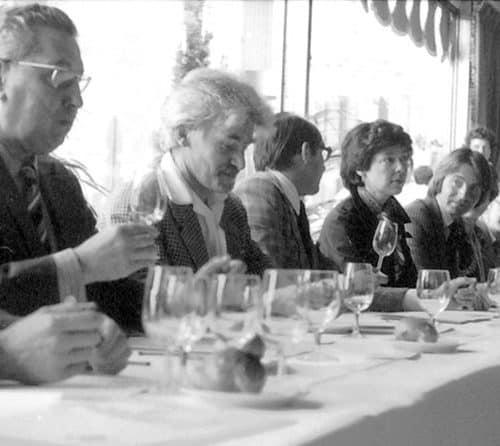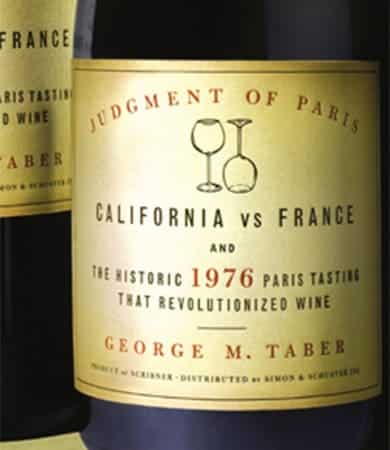MAY 24, 1976 | HISTORY
The Paris Tasting
One of the most influential moments in wine industry history came about as the brainchild of two renowned wine enthusiasts – Steven Spurrier and Patricia Gallagher. The pair decided it would be fun to organize a blind tasting to coincide with America’s Bicentennial celebrations in 1976. For the tasting, he gathered together the best French judges, the finest French wines, and to salute America on its 200th anniversary he added in a few wines from some upstart winemakers in California. Spurrier hoped the tasting would bring favorable attention to his wine shop, but he didn’t have any idea of the impact that his Bicentennial tasting would have on the world of wine.
In order to ensure his selections made it through the long trip from California to France, Spurrier enlisted the help of wine tourism expert Joanne DePuy, who had been the one to show him around Napa Valley on his initial visit. She and Andre Tchelistcheff had organized a tour of France for a select group of American vintners, and agreed to ferry the best of California’s wines to Spurrier’s wine shop in Paris – a favor from DePuy that enabled what would come to be known as “The Judgement of Paris.”
The blind tasting was held at the InterContinental Hotel in the center of Paris. The morning competition was devoted to white wines and the afternoon was devoted to the reds. And Steven Spurrier brought together the very best white wines of Burgundy.
Alongside these French legends there was the 1973 Chateau Montelena Chardonnay crafted by Mike Grgich, and other Chardonnays from California that the French judges had never heard of either. The judges expected to sniff and gag when they tasted the California wines.
But it didn’t happen that way. The nine French judges blind tasted the white wines and graded each of them. The winner was the Chateau Montelena Chardonnay that Mike Grgich had made, with 132 points, the highest total scored of any of the wines, red or white, in the tasting. It was the champion! Then, to add insult to injury, the third and fourth places went to Chalone Vineyard and Spring Mountain Vineyard.
In the afternoon tasting of the red wines, the French judges gave their top ranking to Warren Winiarski for his 1973 Stag’s Leap Cabernet Sauvignon, beating the best wines of Bordeaux, among them a 1970 Château Mouton-Rothschild, a 1970 Château Haut Brion, a 1970 Château Montrose from Saint-Estèphe, and a 1971 Château Léoville-Las-Cases from Saint-Julien.
The judges were shocked as was Steven Spurrier. Upstarts from the Napa Valley had won both categories, against the very best wines of France. The French judges were speechless and a few tried to suppress the results, but without success. The following week, George Taber’s story in Time magazine announced the American triumph, and it sent shock waves throughout the world of wine. Mike received the news that they had won by a congratulatory telegram from Jim Barrett in Paris. That was the first he learned that his wine was even in the competition. There were no details, and he still wasn’t quite sure what had happened but he knew that something significant had taken place.
Soon, though, the importance of what had happened began to sink in. Mike Grgich modestly told some people that it was just luck. But luck is the product of preparation and opportunity. In his heart, he felt this was definitely a miracle, the second in his life as a winemaker. The “Judgment of Paris” gave him security and pride. It also convinced him that he was ready to do more. He was at last ready to go out and start his own winery. On July 4, 1977, Mike Grgich and Austin Hills, of the Hills Bros. Coffee Company, broke ground to start Grgich Hills Cellar, which from the start sold wines that were in high demand, based on Mike Grgich’s reputation as the winemaker who won the Paris Tasting. Gradually, the winery purchased 366 acres, spread over five vineyards within the Napa Valley, allowing all Grgich Hills wines to be produced solely from estate grown grapes. In recognition of that significant achievement, the winery changed its name to Grgich Hills Estate.
The Impact of the Paris Tasting
The Paris Tasting revolutionized the wine world, establishing Napa Valley’s reputation as a world-class wine region! First, it shattered the myth that only French soil can produce world-class wines. For decades New World winemakers had all been stuck in that mindset and this finally broke through it. Second, the victory pumped new energy into the California wine industry, particularly in the Napa Valley. Vintners were proud to be part of what was a revolution in American wine but they still had a long way to go. So they redoubled their efforts to make better wines each year.
California’s victory also inspired other winemakers in different parts of the world. Breaking the myth of French superiority gave new hope and energy to winemakers in South Africa, Italy, Chile, Australia, New Zealand, and even in Mike’s native Croatia. Now they joined the race to make world-class wines, and as the years unfolded California winemakers also shared with them their technology and know-how. As part of that effort, Mike returned to Croatia in 1996 and started a new winery in order to share what he had learned with young winemakers in his homeland. George Taber, the Time magazine journalist who first reported the tasting, in 2005 wrote a detailed account of the event and its impact in his book, “Judgment of Paris: California vs. France and the Historic 1976 Paris Tasting That Revolutionized Wine.” The book has been translated into nine languages, including Japanese and Croatian.
As a result of his historic contributions to making world-class wine in California, Miljenko “Mike” Grgich was inducted into the Vintner Hall of Fame in 2008.


